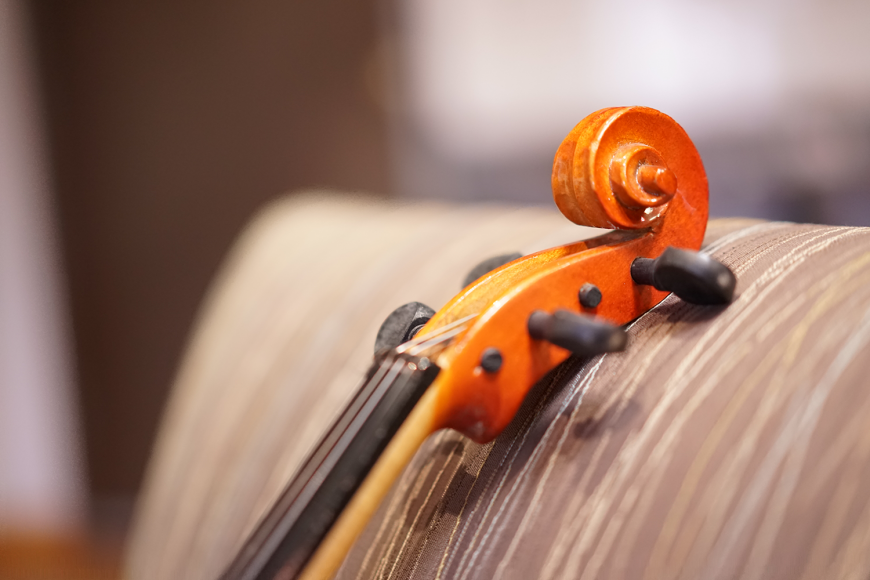Tuning Your Violin

Tuning the violin isn’t difficult, but with a few tips and tricks, you can learn to tune quickly and easily.
Most beginner violins have two options for tuning: the pegs and the fine tuners. The fine tuners make small adjustments, and the pegs make larger adjustments. It’s best to use the fine tuners if you can, but if your string is more than a half step off, you’ll want to use the pegs.
Each string is tuned to a certain pitch. Starting with the thickest string, your violin strings are G, D, A, and E.
Tuners
Whether you use a tuning app or a portable tuner, most tuners work the same way. When you pluck or bow the string, the tuner will indicate what pitch the string is vibrating at. Tuners have a moving pointer, flashing lights, or a moving bar to indicate if you are too low or too high. Anything pointing to the left or flat side means you are too low. Anything on the right or sharp side means you are too high.
A little bit of theory
The musical “alphabet” has seven “letters:” A, B, C, D, E, F, and G. If you are tuning your G string and the tuner indicates an “F,” your string is a whole step too low, and you’ll need to use the pegs to tune up.
Sometimes, your tuner will flash green telling you your note is in tune. Make sure there are no flat or sharp symbols next to the pitch. You could accidently tune your violin to all flat pitches!
Pegs vs. fine tuners
Try to use your fine tuners if you can. Hold the violin in your lap with the front facing you. Pluck each string with one hand and adjust the tuners with the other hand. If you are too low, you will want to turn the fine tuners clockwise or to the right. If you are too high, turn the fine tuners counterclockwise to the left.
A flat or sharp symbol next to the correct pitch means you are a half step away from the correct pitch. For a distance any greater than a half step, you will want to use your pegs.
When using the pegs, first trace the string up to make sure you are turning the correct peg. Gently turn the peg towards you, regardless of whether you need to tune up or down. You might hear a click or feel the tension release from the peg. This allows you to turn the peg easier. If you are too low and need to tuner higher, push in as you turn the peg away from yourself. You can also hold the neck with your other hand to give yourself something to push against. You want to make sure you are pushing into the peg box as you turn to keep your pegs from slipping.
Make small adjustments with the pegs and check the pitch by plucking with your free hand. It’s easy to over tighten the string when using the peg, especially when tuning the E string, so check the string frequently. When you get close to the correct pitch, you can use your fine tuner.
If the fine tuner has been tightened as far as it will go, loosen the fine tuner then use the pegs to get the string close to the correct pitch.
It’s a great idea to always have an extra set of strings. You never know when you might accidently break one!
When Tuning Isn’t That Easy
Normally, a violin will stay relatively in tune, even if you don’t play for a few days. Different factors can make tuning a nightmare. Changes in weather can make the strings go out of tune, but if you are consistently having problems, you might want to make some changes. There are some usual culprits when it comes to unruly strings.
Old Strings
Old strings can be difficult to keep in tune. Change your strings at least once a year. If you play a few hours a day, you’ll want to change your strings more often. If you are playing a used violin, or if you instrument hasn’t been played in several years, change the strings first.
Slipping/Sticking Pegs
Wooden pegs are subject to changes in weather. Low humidity makes them shrink and slip. High humidity makes them swell and stick. Peg paste, drops, or compounds can help with slippage, but you do have to remove the string, remove the peg from the peg box, apply the product, and then reinstall the peg and the string. Once the compound wears away, you will have to redo the process all over again.
If the strings are wound haphazardly around the peg, the pegs may slip or stick. Another problem could be with the pegs themselves. Wooden pegs are tapered to fit the peg hole exactly. If they don’t fit correctly, the peg won’t work. The only solution is to take your instrument to a luthier to have the pegs refitted. If you must have the pegs worked on, you may want to consider new pegs altogether.
Perfection, or planetary pegs look the same as traditional pegs but have gears inside of them. They are great for beginners or professionals. I use perfection pegs on all of my violins. They work smoothly like fine tuners with no slipping or sticking, and they aren’t as subject to changes in weather. They also stay in tune for longer. When you do have to tune, the process rarely takes more than a minute, even if you are badly out of tune. The pegs are that easy to use!
Substandard Instruments
Thrift store violins or cheap internet violins may seem like a good deal, but often times they are unplayable and un-tunable! If you are purchasing a used violin, have your teacher or a luthier look over it first. Sometimes the repairs to make it playable will cost more than the instrument.
Cheaply made violins are all over the internet. You will hear these referred to as VSOs—violin shaped objects. The materials are inferior and the set-up so poorly done that keeping them in tune may be impossible. Purchase violins from reputable dealers, luthiers, or string shops to ensure you have the best possible setup.
When To Tune
Tune every time you play! Since there are no frets on the violin, your ears and muscle memory help you place your fingers correctly. If your string is slightly different every time you play, your ears and your muscles won’t be able to work together to develop that all-important muscle memory! In fact, tuning carefully before you play is one of the best things you can do to ensure a productive lesson or practice session.
Happy Tuning!
Learn more with Lora Gallman: Book a trial violin lesson online
Violin Classes and Tutorials
Ms. Gallman is a wonderful teacher. She has the most pleasant personality, and is a joy to have as a teacher.




